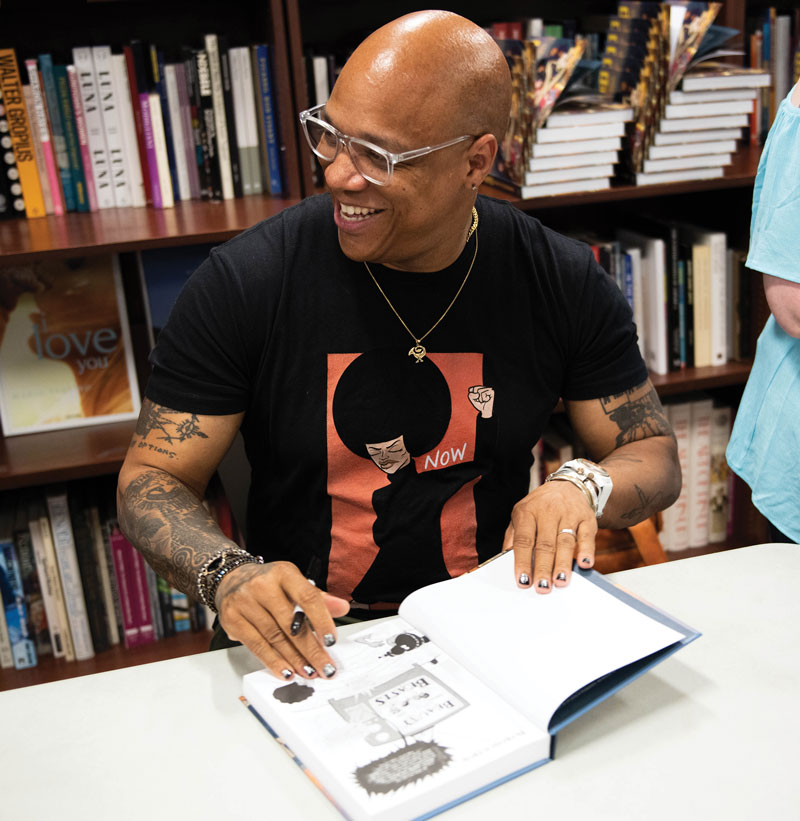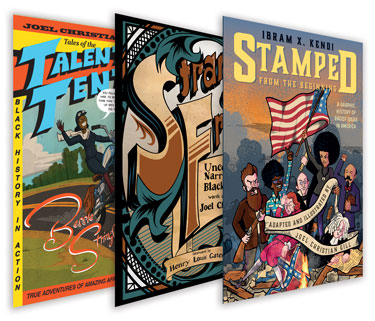How Graphic Novelist Joel Christian Gill Spotlights Black History
“Because Black history isn’t centered, you have to search harder for those stories,” says Gill, who has researched figures including Spottswood Rice, who escaped enslavement and joined the Union Army, and motorcyclist Bessie Stringfield.
 |
Photo by Tami Nguyen |
More authors on researching Black history |
Research is an active verb to Joel Christian Gill, creator of the graphic novel series “Strange Fruit: Uncelebrated Narratives from Black History” and “Tales of the Talented Tenth” (both Fulcrum).
“It’s actually getting out there and going places and making lists and keeping notes and making sure that your handwriting is clean so that you can read that note later,” he says.
Gill’s most recent project, Stamped from the Beginning: A Graphic History of Racist Ideas in America (Ten Speed, 2023), required more visual research than anything else, as it was an adaptation of Ibram X. Kendi’s Stamped. But for his earlier books, Gill had to dig deep.
“Because Black history isn’t centered, you have to search harder for those stories,” he says. Gill credits Brian Sieveking, one of his professors at Roanoke College, for an invaluable piece of advice: “There’s always some little historical society somewhere who keeps records of those things.”

Finding those resources has been key to Gill’s work. When he was researching Malaga Island in Maine for “Strange Fruit,” he couldn’t find much online about the island, which had been a home to thriving interracial community until the residents were forcibly evicted in 1912. So he turned to the locals.
“Somebody that I knew lived in Phippsburg, Maine,” he says, “and they went to the historical society and got a ton of information that they had collected, and pictures of people.”
Similarly, while researching the chapter on cyclist Major Taylor, he found a cycling club in Worcester, MA, that had information about Taylor that couldn’t be found anywhere else.
Even the most careful researcher can be tripped up by the human factor, however. Gill relied entirely on contemporary sources for his research on motorcyclist Bessie Stringfield, including a newspaper interview with Stringfield herself and conversations with a biker blogger who knew her. Then, in 2018, four years after the publication of Bessie Stringfield: Tales of the Talented Tenth, the New York Times ran an obituary with some new information: Stringfield had lied about her family and her past, telling reporters that she was born in Jamaica, orphaned at an early age, and taken in by a kindly woman who gave her her first motorcycle. In fact, she was born in North Carolina and still had living relatives. Gill corrected the record for his picture book Fast Enough: Bessie Stringfield’s First Ride (Lion Forge, 2019), and he plans to do the same with the graphic novel if it is reissued.
By contrast, Gill hit research pay dirt with the story of Spottswood Rice, an enslaved African man who escaped, joined the Union Army, and sent letters to his daughter and her enslaver saying that he was coming to rescue his child. “I found the letter, I found his military records, I found all this other stuff,” Gill says. “And then I found a 1925 interview with his daughter where she actually says that was true.”
Because historical records about African Americans are often sparse, Gill sometimes has to fill in the blanks with less specific knowledge. When he was researching stage magician Richard Potter, material about Potter’s early days was hard to come by. “I don’t know where he performed for the first time,” Gill says. “So I had to think, where did people perform in Boston? You have to build the story around the things that point to other things.”
Gill, an associate professor of art at Boston University and chair of the Department of Visual Narrative, makes heavy use of libraries, the JSTOR database, and newspaper archives, but he checks and cross-references everything.
“My bias is in favor of the truth. And if I can’t find multiple things that sort of corroborate what I’m talking about, I don’t talk about it.”
Currently, Gill is working on a graphic novel about abolition and the Civil War that incorporates historical figures into the narrative. He’s planning a fact-finding trip to Richmond, VA, to find information about abolitionist, socialite, and Union spy Elizabeth Van Lew. “The fun thing about historical research is, if you’re a person who likes puzzles and likes puzzles that actually can be solved in some instances, then [this is] definitely for you.”
RELATED
The job outlook in 2030: Librarians will be in demand
The job outlook in 2030: Librarians will be in demand
ALREADY A SUBSCRIBER? LOG IN
We are currently offering this content for free. Sign up now to activate your personal profile, where you can save articles for future viewing






Add Comment :-
Be the first reader to comment.
Comment Policy:
Comment should not be empty !!!